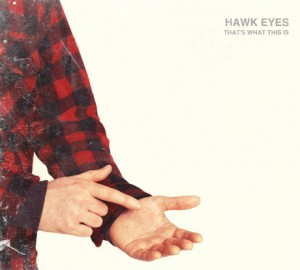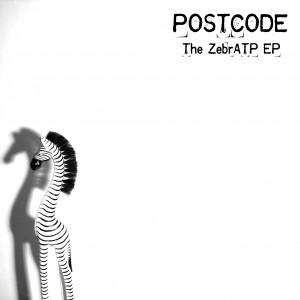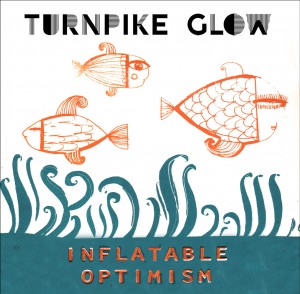 Hawk Eyes’ 2013 release ‘That’s What This Is’ was funded by fans via a kickstarter campaign – and for the fans, their money was well spent as the Leeds math/alt-metal outfit offers another selection of tunes which manage to combine difficult and angular aggressiveness with moments of surprising melody.
Hawk Eyes’ 2013 release ‘That’s What This Is’ was funded by fans via a kickstarter campaign – and for the fans, their money was well spent as the Leeds math/alt-metal outfit offers another selection of tunes which manage to combine difficult and angular aggressiveness with moments of surprising melody.
Category Archives: alternative
POSTCODE – ZebrATP EP
 In 2007, Postcode released their debut full-length album ‘Zebracore’. Both this record and it’s follow up (‘Zebraland’) were loaded with overdriven guitar lines, fuzzed out vocals and a truckload of distortion – as if The Breeders had merged with Bikini Kill and asked Steve Albini to record a bunch of songs on the fly.
In 2007, Postcode released their debut full-length album ‘Zebracore’. Both this record and it’s follow up (‘Zebraland’) were loaded with overdriven guitar lines, fuzzed out vocals and a truckload of distortion – as if The Breeders had merged with Bikini Kill and asked Steve Albini to record a bunch of songs on the fly.
TURNPIKE GLOW – Inflatable Optimism EP
 The four songs on this debut EP by Turnpike Glow present the beginnings of a band with a great talent. There are various influences at play, and although each of them add plenty of colour to this London indie-rock quartet’s sound, there’s never anything that’s obviously plagiarised. This is a band talented enough to borrow various styles and meld them into their own style, which throughout this release, treads a fine line between rhythmic sharpness and a garagey fuzziness. Fuzz is cool, but, most importantly, Turnpike Glow have the songs necessary to back up the tunes – and a couple of them are absolutely terrific.
The four songs on this debut EP by Turnpike Glow present the beginnings of a band with a great talent. There are various influences at play, and although each of them add plenty of colour to this London indie-rock quartet’s sound, there’s never anything that’s obviously plagiarised. This is a band talented enough to borrow various styles and meld them into their own style, which throughout this release, treads a fine line between rhythmic sharpness and a garagey fuzziness. Fuzz is cool, but, most importantly, Turnpike Glow have the songs necessary to back up the tunes – and a couple of them are absolutely terrific.
On two of the EP’s numbers, Turnpike Glow’s sound is rooted within 21st century indie pop. ‘No More Dancing’ comes with a slightly distorted vocal, while a particularly loud drum gives things an extra edge. From time to time, a few surprisingly funky moments hint at bands like Frankie & The Heartstrings – but only much better. A similar mood drives ‘Marie’, largely thanks to Anthony Hutchinson’s tight drum grooves, over which some catchy woo-hoo vocals and occasionally surprising harmonies greet the ear. Digging beneath the loud drum, you’ll also discover some lovely bass runs which, while relatively busy, are always melodic. These tunes alone would be strong enough to recommend Turnpike Glow, but ‘Inflatable Optimism’s other pair of numbers are much stronger.
The EP’s unmissable tracks take the best elements of Turnpike Glow’s general sound and dish up something a touch more new wave influenced. By the time ‘1986’ kicks in, there’s a vibe of an early XTC number played by Robert Pollard’s Boston Spaceships. Guiseppe La Mela’s vocal is, again, distorted and a little ugly in places, although this is balanced out by a ridiculously catchy hook which isn’t even diminished by the presence of odd falsetto yelping. With a spiky rhythm, largely driven by fuzzed up bass, ‘The Turn, The Pike, The Glow’ features great performances from each band member, but of particular note here are the ringing lead guitar parts connecting the verses. Combined with another upfront drum part, they help to give this track a real feeling of urgency.
With a perfect mix of strong songs, great musicianship and a decent amount of controlled aggression, Turnpike Glow are worth seeking out. In short: If you like things with a strong indie-rock bias, you’ll want this. You can stream the EP via the widget below. [Also, watch the video clip for ‘The Turn, The Pike and The Glow’ at Popdodger.]
October 2012
LYN SAGA – Venice
 Appearances can be deceiving. Despite the presence of a guitar, one look at Lyn Saga’s debut full-length album and you may be forgiven for thinking it is an album of shiny pop aimed at the teen market. Her love of the pop-sock and the list of “fun facts” on her website [such as “Lyn’s favourite colour is purple. Lyn uses arpeggios of cat noises as warm up tapes for shows” etc] may not be instantly attractive – or of any real importance – to the more mature audience either. Here are the real facts about Lyn Saga: in her formative years, Lyn Saga spent every penny she could collecting records by the eras alternative rock greats. Citing the likes of Hole, Smashing Pumpkins, Fountains of Wayne and Weezer among her early influences, she takes everything she’s ever learnt from those bands (particularly the latter) and, with her obvious ability to write catchy hooks, created a wonderfully radiant debut release.
Appearances can be deceiving. Despite the presence of a guitar, one look at Lyn Saga’s debut full-length album and you may be forgiven for thinking it is an album of shiny pop aimed at the teen market. Her love of the pop-sock and the list of “fun facts” on her website [such as “Lyn’s favourite colour is purple. Lyn uses arpeggios of cat noises as warm up tapes for shows” etc] may not be instantly attractive – or of any real importance – to the more mature audience either. Here are the real facts about Lyn Saga: in her formative years, Lyn Saga spent every penny she could collecting records by the eras alternative rock greats. Citing the likes of Hole, Smashing Pumpkins, Fountains of Wayne and Weezer among her early influences, she takes everything she’s ever learnt from those bands (particularly the latter) and, with her obvious ability to write catchy hooks, created a wonderfully radiant debut release.
Beginning with the title cut, the sheer weightiness of the music should win over most alt-rock/power pop afficianados. The intro cheekily uses a similar guitar tone to ‘Smells Like Teen Spirit’, before a chunky riff in the vein of Fountains of Wayne in an aggressive mood takes over. Naturally, Saga’s vocal is a little sugary, but since the combination of cutesy voice and gritty music recalls Kay Hanley and Letters To Cleo, that’s very appealing. The combination of its key influences may be obvious, but Saga pulls together all the elements to create something enjoyable. Just as she cheekily began the tune with something familiar, the blatant steal from Weezer’s ‘Buddy Holly’ at the close should raise a wry smile.
While that sets the tone for the rest of the album, the ante is upped by a couple of the following tunes. One such number ‘This Way’ comes with a marching time signature which pulls the best from the hard chord structure and Saga’s vocal, but better still, it’s embellished with brass. Such an arrangement keeps things incredibly buoyant and the upbeat qualities really hit home via a brief section clearly inspired by The Beach Boys ‘God Only Knows’. The sunny musical vibes are often at odds with the hard confessional lyric regarding greater understanding and maturity, but that contrast makes this superb.
‘Life Is But a Dream’ could be accused of not using as much of Saga’s own style as before, since it’s even more of a blatent Weezer homage – right down to the brief stops in the chorus – but like Tally Hall’s ‘Two Wuv’, that isn’t necessary a bad thing. The merest mention of Weezer means you’ll already have very strong ideas of how this sounds. However, looking at the overall performance, there’s merit here: most of the melody is carried by a multi-tracked vocal, while a strong bassline and twin lead guitar solo provide the instrumental high points. With its 90s chug colliding with a 50s doo wop lilt, ‘Runaway’ showcases almost as much love for Rivers Cuomo, but is perhaps a slightly better tune thanks to a more obvious sense of light and shade. The chugging Weezer-isms are joined by strong pop vibe – equal parts that dog. and Letters To Cleo – resulting in more predictable (yet wholly enjoyable) retro rock. As to whether Lyn Saga’s influences are perhaps a little too obvious, given how many copies Weezer’s blue album sold in the US in the mid 90s, it’s only natural they would be a seminal influence for many. Frankly, though, this album is much better than some of the other Weezer-style releases that have followed in the wake of that debut…including most of Weezer’s own work.
On the surface, ‘I Believe’ sticks out a little with a poppier bias and a sound that feels a touch more mechanical. The lightness of the vocal gets a lighter tune to match, where the driving drum part – for once – takes precedence over the usual wall of guitars. There’s a near danceable groove reinforced by a lot of hi-hat work, but digging deeper, Saga’s more typical Fountains of Wayne and Weezer obsessions are still in there with an occasional guitar part fighting to get out. Perhaps the album’s most interesting number all round, ‘I Didn’t Mean To’ revisits the kind of punchy verses which adorn most of ‘Venice’s best tunes, this time adopting a marching beat. To add extra interest, the previous power pop elements are complimented a touch of vaudeville jazziness. Centring around piano and glockenspiel accompaniments, these interludes recall works by the brilliant Hush Sound.
Using filters to give the impression of an older recording during its verses, Saga sounds like she’s singing down a telephone on the closing number, ‘We Didn’t Realise’. This works fine against the samba-esque rhythms employed and provides a great contrast to the chorus sections where she reverts back into the hard-hitting Weezer/Anna Waronker /Letters To Cleo hybrid which she’s wisely chosen as her main calling card.
Comprising ten songs and clocking in at just half an hour, this is an excellent example of how to make a streamlined album with no obvious filler, the way people used to when approximately fifteen to twenty minutes of music per side constituted a full release. Although ‘Venice’ is somewhat formulaic in places, if you dig any of the bands mentioned here, Lyn Saga should certainly be on your list of artists to investigate.
January 2013
SINK SWIM – Heights EP
 In the summer of 2012, Californian emo/alt-rock outfit Sink Swim issued their debut EP. While it didn’t really push their chosen genre’s boundaries, it featured a few really enjoyable songs. Although their follow-up release ‘Heights’ has their original sound at the centre, it does more than just pick up where they left off. With previous producer Robert “Bob” Curtin at the controls, you can be assured that – once again – it sounds great, but this time around the band have really toughened up their overall sound.
In the summer of 2012, Californian emo/alt-rock outfit Sink Swim issued their debut EP. While it didn’t really push their chosen genre’s boundaries, it featured a few really enjoyable songs. Although their follow-up release ‘Heights’ has their original sound at the centre, it does more than just pick up where they left off. With previous producer Robert “Bob” Curtin at the controls, you can be assured that – once again – it sounds great, but this time around the band have really toughened up their overall sound.
That toughness is evident right from a minute or so into opening track ‘Tides’. Following a brief intro of multi-tracked guitars, coupled with a familiar emo-ish vocal line, the band move into an already agreeable tune, but its during the post-chorus section where things really pick up: the guitars adopt a shrill shredding sound and the drums tackle brief spells of double bass pedal driven beefiness. To counterbalance this harder edge, Dane Petersen’s usual vocal style gives way for something far more metaiiic, shifting the overall mood farther towards the lightest end of metalcore. A little more accessible on early listens, ‘Move Me’ finds Sink Swim experimenting with quirky time signatures, something particularly obvious with regard to the guitar riff. Jake Lopez’s playing is busy, almost jazzy in tone, showing influences from the burgeoning math-rock scene; the rest of the band fall in line behind him, eventually settling into a pleasant alt-rock groove. The off-beat time signature re-appears on what passes as a chorus, but never becomes intrusive. As if ‘Take This To Your Grave’ era Fall Out Boy jammed with Wot Gorilla? on a Foals number, the results are both quirky and enjoyable.
Settling for something more straight ahead, ‘Perfect On Paper’ is a guitar-driven rock number which exploits the band’s influences from the louder end of the emo movement. Gang vocals lend a huge whoah, providing most of the main hook while slightly grubby sounding guitars take the weight of the melody. This isn’t as interesting as some of the EPs other material, but, perhaps, provides the strongest link with the band’s earlier work.
The other pair of tunes do not showcase anything particular different to the styles present in the previous numbers. Perhaps this EP’s weakest offering, the title cut is a weighty emo-ballad that somehow seems twice as long as it actually is, while ‘Pull Together’ – another mid-pacer, has a much better melody, lifted by some decent ringing guitar lurking in the back and a guest vocal from Love, Robot’s Alexa San Roman. Broadly speaking, both tunes are okay – and given a sense of gravitas via Bob Curtin’s production – but neither inspires quite in the way the band are capable when they really push themselves (as with ‘Tides’, for example).
Between their two releases, Sink Swim have honed their sound into a sharper, tougher, animal that hits the perfect balance between math-rock aggressiveness and alt-rock tunefulness. Although it tails of a little towards the end, there’s more than enough to recommend this EP to fans of math-rock and the lighter end of alt-rock. …And to those already familiar with Sink Swim: if you liked ‘Elements’, chances are you will love ‘Heights’.
January 2013
